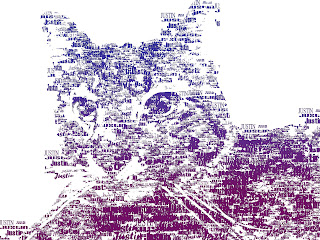A couple weeks ago, some friends, our professor, and I began our Mokume Gane journey of 2011. Let me explain.
Mokume Gane is a japanese metal-fusing technique that offers the most BEAUTIFUL patterns in the metal. Here, let me show you:
(All these pictures are samples that Ted McDonah brought with him when he came to show us this technique in Fall 2009.)
Cool, right? Here's how it goes down:
First, We need a LOT of metal. The billet (that's what we call the big hunk of metal that all these sheets of metal will become) consists of around 25ish (depending on what you want) sheets of metal that are 2x3 inches each. The stack ends up being around 1 inch. This picture (above) shows my stack of metal in the contraption we use for firing it. My thumb is in there to show some perspective. Oh, ps-the metal has to be REALLY clean. SUPER clean. It took quite a while to clean all this metal properly.
Once the metal is all ready, we fire up the forge. We use propane gas and that forge gets so hot, sitting in front of it is almost unbearable.
Every minute, I had to flip the billet over. It's not that heavy, but it's at the end of a long pole. Plus the forge is small so the billet has to be turned in one spot. It's somewhat difficult, and we realized pretty early that using a stool to rest the supporting elbow on is the only way to do it.
After about 7 minutes or so, the billet is done cooking, so we take it out. As you can see from Lauren's face, it's REALLY hot.
Then, to get it out, the bolts have to come off.....while it's hot....
Once the billet is out, it gets forged down on the anvil. This process takes a while, and gets done at several different points in the mokume process. The billet gets hit with a heavy hammer, then put back in the forge to anneal, then hit again, then back in the forge, over and over again.
Finally, we end up with a billet that looks like this. It's about 1/2 an inch high now. Those blobs poking out are the unknown alloy that seeps out during the forging process. It's not really a useful material, but it's still fun to collect it.
Now the "fun" part. The sides have to get cut off. During the forging, cracks frequently form on the sides of the billet. The billet has to be cut down so that those cracks get cut off. If the cracks don't get cut off, they will just get longer and longer. Even using the hacksaw, it takes about 45 minutes to cut the short side of the billet! We eventually moved to the band saw, but it still takes about 20 minutes each side. You can see all the layers squished into the billet.
So more forging happens and the billet gets down to about 1/4 inch. This is when the patterning can happen. All the different patterns in the first pictures are made in different ways. Drilling, twisting, denting, and stretching all combine to form various patterns. During the patterning process, the billet continues to be heated and forged with the hammer.
We ran out of gas for the forge this most recent time, so we are stuck for the time being. Currently we are at the "cutting off the sides" stage. From start to finish, this process takes a very long time. I mean it can take weeks. I imagine if someone devoted all their time to this process and didn't do anything else during it, AND if they had someone to trade off swinging the hammer (your arms start to hurt REALLY bad), this imaginary person could probably do this whole process in a few days. Buuuutttt that's not how it happens in our world.
Me and my glowing billet. It was...warm.











































